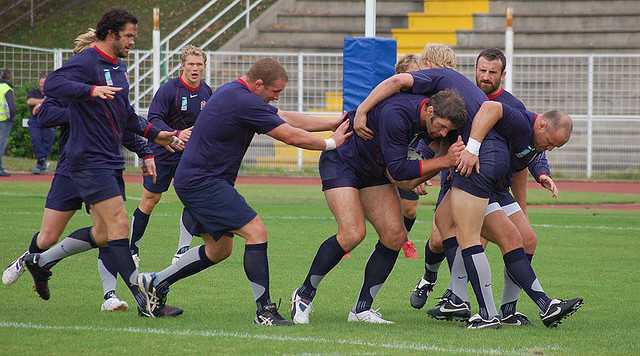A couple of years ago, I wrote a blog about an interesting article by Hides and Stanton that related size and strength of the multifidus to the risk for lower extremity injury in Australian professional football players.
 Now some of the same researchers are looking above. A prospective cohort study has recently been published that examined factors and their effects on concussions. Physical measurements of risk factors were taken in pre-season among Australian football players. These measurements included balance, vestibular function, and spinal control. To measure these outcomes the following tests were included: for balance the amount of sway across six test conditions were performed; vestibular function was tested with assessments of ocular-motor and vestibular ocular reflex; and for spinal control cervical joint position error, multifidus size, and contraction ability was tested. The objective measure was concussion injury obtained during the season diagnosed by the medical staff.
Now some of the same researchers are looking above. A prospective cohort study has recently been published that examined factors and their effects on concussions. Physical measurements of risk factors were taken in pre-season among Australian football players. These measurements included balance, vestibular function, and spinal control. To measure these outcomes the following tests were included: for balance the amount of sway across six test conditions were performed; vestibular function was tested with assessments of ocular-motor and vestibular ocular reflex; and for spinal control cervical joint position error, multifidus size, and contraction ability was tested. The objective measure was concussion injury obtained during the season diagnosed by the medical staff.
The findings were so interesting! Age, height, weight, and number of years playing football were not associated with concussion. Cross-sectional area of the multifidus at L5 was 10% smaller in players who went on to sustain a concussion compared to players that did not receive a concussion. There were no significant differences observed between the players that received concussion and those who did not with respect to the other physical measures that were obtained.
With all the recent evidence about the harmful effects of concussions amongst our athletes, I find this information amazing and am excited to see where the researchers take this in the future. The next question for the physical therapist is how do we train the multifidus? The multifidus can be difficult to retrain in some individuals. It is a hard muscle for some patients to learn to recruit. Biofeedback using ultrasound imaging can make this daunting task easier for many patients. With the cost of ultrasound units coming down, it is also a very reasonable tool for clinics to look at investing in.
Join me to learn more about the multifidus and how to use ultrasound imaging in the retraining process. Future course offerings include August in New Jersey, and November in San Diego. I look forward to seeing you there!
Hides, Stanton. Can motor control training lower the risk of injury for professional football players? Med Sci Sports Exerc. 2014; 46(4): 762-8.
Leung, Hides, Franettovich Smith, et al. Spinal control is related to concussion in professional footballers. Brit J of Sports Med. 2017; 51(11).
How often do we hear of patients trying to explain their sexual pain to a partner, only to be doubted, not believed, or guilt tripped into having sex because of the lack of understanding of the condition? I’d say about as often as we hear of the other unfortunate misunderstandings about the nature of painful sexual function, such as people not wanting to be in a relationship for fear of sexual dysfunction limiting their participation, or believing that healthy sex is gone for good. Most of us are familiar with the phrase, “not tonight- I’ve got a headache” yet how often is the truth really that a person has a “pelvic ache?” And do headaches and pelvic pain go together? That is the question posed in research published in the journal Headache.
 For 72 women who were being treated for chronic headache, a survey was administered to assess for associations between sexual pain and libido, a history of abuse, and to determine the number of women being treated for sexual pain. Nearly 71% of the women were diagnosed on the International Classification of Headache Disorders (ICHD)-III criteria with chronic migraines, nearly 17% with medication overuse headache, 10% with both chronic overuse headache and migraine. Below are some of the statistics from the survey.
For 72 women who were being treated for chronic headache, a survey was administered to assess for associations between sexual pain and libido, a history of abuse, and to determine the number of women being treated for sexual pain. Nearly 71% of the women were diagnosed on the International Classification of Headache Disorders (ICHD)-III criteria with chronic migraines, nearly 17% with medication overuse headache, 10% with both chronic overuse headache and migraine. Below are some of the statistics from the survey.
| Symptom | % Respondents who Experienced Symptom |
| Pelvic region pain brought on by sexual activity | 44% |
| Pelvic region pain preventing from engaging in sexual activity | 18% |
| Among women who had pain: | |
| Reported pain for < 1 year | 3% |
| Reported pain for 1-5 years | 35% |
| Reported pain for 6-10 years | 29% |
| Reported pain for > 10 years | 32% |
Although the next statistics should not be so surprising based on prior literature and on our work in the clinics, 50% of the women had not discussed their pelvic pain with a provider. Of the women who had discussed their pelvic pain with a provider, 37.5% were currently receiving treatment, 31% had not received any treatment, 31% had received care in the past, and 1% did not provide an answer. Reasons for not receiving treatment included that no treatment was offered, pain was not severe enough to warrant care, or fear of pursuing treatment due to embarrassment. Unfortunately, rehabilitation was not a significant part of the treatment plan, even though all but one of the women said they would want to pursue care if available.
Other interesting associations were made in the article, which is available as full text in the link above, including rates of sexual abuse, and associations between types of headaches and pelvic pain. The bottom line is that headaches and pelvic pain can occur together, and that based on this research, many women are still suffering for long periods of time without accessing care for pelvic pain. When it comes to headaches, there are many types of headaches, and many other conditions that occur and can cause pain in the head, face, and neck. If you would like to sharpen your clinical tools related to headaches, as well as dizziness and vertigo, you still have time to sign up for the Institute’s new continuing education course on Neck Pain, Headaches, Dizziness, and Vertigo that takes place in Rockville in November.
Today we get to hear from Mitch Owens, MsPT, COMT who is the author and instructor of "Neck Pain, Headaches, Dizziness, and Vertigo: Integrating Vestibular and Orthopedic Treatment". Join Mitch in Rockville, MD on November 14-15 in order to learn more about treating patients with head trauma.
 Following a whiplash injury, concussion or vestibulopathy patients will complain of the same cluster of symptoms: neck pain, dizziness, and headache. In order to properly treat patients complaining of these symptoms a clinician must first be able to determine the source and understand the physiology at work to reason out the best plan of care.
Following a whiplash injury, concussion or vestibulopathy patients will complain of the same cluster of symptoms: neck pain, dizziness, and headache. In order to properly treat patients complaining of these symptoms a clinician must first be able to determine the source and understand the physiology at work to reason out the best plan of care.
Treating individuals for dizziness, neck pain and headaches requires a refined understanding of the systems involved, the clinical tests that can be used to differentiate symptom generation and then finally which evidence based interventions should be deployed.
A patient who presents with a complaint of dizziness or vertigo following a trauma to the head or neck will challenge the examination skills of even the best practitioners. The list of differential diagnosis includes a number of conditions that could prove to be quite threatening to the patient with or without intervention. These conditions include: vertebral basilar insufficiency, cervical fracture, dislocation or instability, stroke, traumatic brain injury, concussion, and peripheral vestibulopathy to name a few. The ability to clinically reason and properly assess these individuals is crucial to the effective management of any orthopedic or neurologic case load.
Clinicians treating either population need skill sets that bridge the orthopedic and neurologic expertise gap that often exist if clinicians. The need to close this gap is highlighted the following facts:
- 15-20% of Benign Paroxysmal Positional Vertigo is caused by trauma (Gordon, Carlos et al. 2004).
- 19% of cases of whiplash demonstrated vestibulopathy with videonystagmography (VNG) testing within 15 days of their accident (Nacci, A. et al 2011).
- 60% of cases of whiplash with head trauma demonstrated vestibulopathy (Nacci, A. et al. 2011).
- Dizziness is reported 20-58% of whiplash patients (Wrisley DM et al. 2000).
- Between 40%-70% of individuals with persistent whiplash associated disorders complain of dizziness (Treleaven, Julia et al. 2003).
- The incidence of cervicogenic dizziness has been reported to be 7.5% of all dizziness (Ardic FN, et al. 2006)
Recent evidence has shown that sensory dysfunction is as much a part of dizziness as it is a component of chronic neck pain (Treleaven, Julia et al. 2003).
Interventions directed at training cervical proprioception have been show to significantly reduce pain and has improved function in patients with chronic neck pain (Revel, Michel, et al 1994). Manual therapy techniques directed at the upper cervical spine have also been shown to effectively treat dizziness in randomized control trials (Reid, Susan A., et al. 2013).
Thus we are learning the ability to effectively measure and treat neurologic dysfunction is an important part of address cervical spine issues. It is equally true that being able to assess and treat cervical spine dysfunction is an important part of treating patients who complain of dizziness.
Enhancing your neurologic and orthopedic skill set is clearly useful for any clinician and will help improve your outcomes across all patient populations. Continued training in these areas will expand what patients you can see, add to your clinical tool belt, and improve your confidence within your current caseload.
References:
Ardic FN, Topuz B, Kara CO. Impact of multiple etiology on dizziness handicap. Otol Neurotol. 2006;27:676 – 680.
Gordon, Carlos R., et al. "Is posttraumatic benign paroxysmal positional vertigo different from the idiopathic form?." Archives of Neurology 61.10 (2004): 1590-1593.
Nacci, A., et al. "Vestibular and stabilometric findings in whiplash injury and minor head trauma." Acta Otorhinolaryngologica Italica 31.6 (2011): 378.
Reid, Susan A., et al. "Comparison of Mulligan Sustained Natural Apophyseal Glides and Maitland Mobilizations for Treatment of Cervicogenic Dizziness: A Randomized Controlled Trial." Physical therapy (2013).
Revel, Michel, et al. "Changes in cervicocephalic kinesthesia after a proprioceptive rehabilitation program in patients with neck pain: a randomized controlled study." Archives of physical medicine and rehabilitation 75.8 (1994): 895-899.
Treleaven, Julia, Gwendolen Jull, and Michele Sterling. "Dizziness and unsteadiness following whiplash injury: characteristic features and relationship with cervical joint position error." Journal of Rehabilitation Medicine 35.1 (2003): 36-43.
Wrisley DM, Sparto PJ, Whitney SL, Furman JM: Cervicogenic dizziness: a review of diagnosis and treatment. Journal of Orthopaedic & Sports Physical Therapy 2000, 30(12):755-766.





































